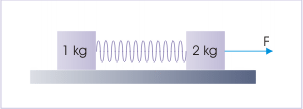| << Chapter < Page | Chapter >> Page > |
We have discussed formulation of conservation of energy in general. In this module, we shall discuss conservation law as applied to mechanical process. Typically, a mechanical process involves three different kinds of energy - kinetic, potential and heat. We shall, however, restrict treatment of heat as an equivalent to work by friction.
On the other hand, the process generally involves gravitational, elastic and friction forces. These forces transfer energy involving different energy forms by doing work on the objects of the system.
Depending on the context of situation, we use either closed or isolated system. Further, mechanical process is generally limited to exchange of energy within or outside the system via “work”. In short, we can describe a mechanical process in terms of following elements :
In order to facilitate systematic study of mechanical process, we shall study three different situations in progressive simplicity of the process :
In this module, we shall discuss the first two processes. Third process represents the ideal mechanical process. The corresponding conservation law is known as “conservation of mechanical energy”. This law is being dealt in a separate module.
One implication of external force on the system is that we are dealing with special “closed” system, which permits exchange of energy with surrounding via “work by external force” only. The form of conservation law for the mechanical process is :
However, we pointed out that we shall limit change in thermal energy to “heat energy”, which is equal to the negative of work by friction only. Hence, we can rewrite the equation as :
In words, we can put the conservation of energy for mechanical process as :
“Work by external force on the system and work by friction within the system is equal to the change in potential and kinetic energy of the system.”
Problem 1: Two blocks of 1 kg and 2 kg are connected by a spring as shown in the figure. If spring constant is 500 N/m and coefficient of static and kinetic friction between surfaces are each 0.5, then what minimum constant horizontal force, F, (in Newton) is required to just initiate block on the left ? (Consider g = 10 ).
Block spring system

Solution : The system consists of two blocks and one spring. The system is subjected to an external force. Thus, system is “closed” system, which allows energy exchange with system via work by external force. As friction is also involved, the corresponding energy statement is :

Notification Switch
Would you like to follow the 'Physics for k-12' conversation and receive update notifications?